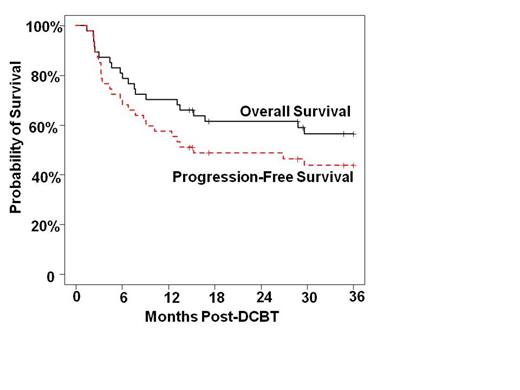Abstract
Introduction: Allogeneic transplantation using double-unit cord blood grafts (DCBT) is an alternative therapy for adult patients with high-risk lymphomas without a HLA-matched sibling or volunteer donor but the efficacy of DCBT in this setting is not established.
Methods: We analyzed overall survival (OS) and progression-free survival (PFS) after 4-6/6 HLA-matched DCBT in adults with B-cell non-Hodgkin lymphoma (NHL) or Hodgkin lymphoma (HL) who were transplanted 2/2006-5/2013.
Results: Patient characteristics by diagnosis are shown in the Table. Overall, the 47 patients (median age 46 years, range 20-70) had a median number of prior treatment regimens of 4 (range 1-13), 22/47 (47%) patients had had a prior autologous transplant, and the median pre-transplant HCT-CI score was 2 (range 0-6). Twenty-eight (60%) were in complete remission (CR). Conditioning was reduced intensity (RI) but functionally myeloablative in 16 patients (8 Cy/Flu/Thio/TBI400, 8 Mel/Flu) and 31 patients received non-myeloablative conditioning (NMA, Cy/Flu/TBI200). CB units had a median infused TNC dose x 107/kg of 2.7 (range 1.5-4.3) for the larger unit and 1.9 (range 0.9-3.4) for the smaller unit and a median donor-recipient HLA-allele match of 5/8 (range 1-7). The cumulative incidence of donor-derived engraftment was 98% (95%CI:77-99) with a median 22 day (range 13-37) and 10 day (range 7-46) neutrophil recovery after RI and NMA conditioning, respectively. Day 100 grade II-IV acute GVHD (20 grade II, 7 grade III, 1 grade IV) and 1-year chronic GVHD were 61% (95%CI:45-74) and 17% (95%CI:8-29), respectively. Day 180 transplant-related mortality (TRM) was 17% (95%CI:8-29). To date, 11 patients have progressive disease (median 3.4 months, range 2.8-58.0). The 3-year cumulative incidence of progression was 22% (95%CI:11-34). With a median 60 month (range 15-101) follow-up of survivors, the 3-year KM estimate of OS and PFS are 56% (95%CI:44-73) and 44% (95%CI:31-61), respectively (Figure). Of 23 patients who have died, 7 died of progressive disease whereas 16 died of transplant complications (2 organ failure, 10 GVHD, 2 infection, 1 encephalopathy of unknown cause, and 1 donor leukemia). Best PFS was observed in patients with follicular NHL (3-year PFS 62%) followed by HL (3-year PFS 47%) whereas those with diffuse large B-cell lymphoma, for example, did poorly (Table). There was no differences in 3-year PFS according to recipient age, HCT-CI, or number of prior regimens (each split above versus below the median), or receipt of a prior autologous transplant (all p = NS). Similarly, patients in CR pre-CBT (n = 28) had a 3-year PFS of 42% as compared to a 46% PFS in the non-CR patients (n = 19), p = 0.568. Four of 11 patients who relapsed survive to date (range 29-81 months) after treatment with chemotherapy (n = 3) or subsequent CB-derived mobilized peripheral blood stem cell (PBSC) transplant (n = 1).
Conclusions: PFS after DCBT in patients with follicular NHL and HL is similar to that of adult donor allograft series and warrants further investigation. However, DCBT in other histologies is not as favorable. The high TRM rates may be influenced by the extent/intensities of prior therapy. Future clinical trials with DCBT should focus on strategies to reduce TRM, especially related to GVHD. Post-transplant maintenance to prevent disease progression could also be beneficial. Finally,chemotherapy to treat post-CBT relapse and CB-derived PBSC transplant are potential therapeutic options in selected patients.
| Disease Type (N) . | Median (range) age . | Median (range) HCT-CI . | Remission status . | Median (range) prior regimens / N prior auto . | Regimen intensity . | PFS . |
|---|---|---|---|---|---|---|
| Follicular (n = 13) | 52 yrs (29-63) | 1 (0-4) | 5 CR, 5 PR, 3 SD | 4 (2-8) / 3/13 (23%) | 3 MA 10 NMA | 3-yr: 62% (95%CI: 40-95) |
| Diffuse large cell (n = 13) | 53 yrs (35-64) | 2 (0-6) | 8 CR, 4 PR, 1 SD | 4 (1-7) / 3/13 (23%) | 4 MA 9 NMA | 3-yr: 23% (95%CI: 9-62) |
| Mantle cell (n = 5) | 57 yrs (37-71) | 2 (1-6) | 5 CR | 3 (2-4) / 4/5 (80%) | 5 NMA | 2 disease-free at 29-70 months |
| Hodgkins (n = 15) | 35 yrs (20-50) | 3 (0-5) | 10 CR, 3 PR, 1 SD, 1 PD | 4 (2-13) / 12/15 (80%) | 8 MA 7 NMA | 3-yr: 47% (95%CI: 27-80) |
| T-cell rich B-cell NHL (n = 1) | 38 yrs | 2 | PR | 7 / No auto | 1 MA | Died at 1.5 months |
| Disease Type (N) . | Median (range) age . | Median (range) HCT-CI . | Remission status . | Median (range) prior regimens / N prior auto . | Regimen intensity . | PFS . |
|---|---|---|---|---|---|---|
| Follicular (n = 13) | 52 yrs (29-63) | 1 (0-4) | 5 CR, 5 PR, 3 SD | 4 (2-8) / 3/13 (23%) | 3 MA 10 NMA | 3-yr: 62% (95%CI: 40-95) |
| Diffuse large cell (n = 13) | 53 yrs (35-64) | 2 (0-6) | 8 CR, 4 PR, 1 SD | 4 (1-7) / 3/13 (23%) | 4 MA 9 NMA | 3-yr: 23% (95%CI: 9-62) |
| Mantle cell (n = 5) | 57 yrs (37-71) | 2 (1-6) | 5 CR | 3 (2-4) / 4/5 (80%) | 5 NMA | 2 disease-free at 29-70 months |
| Hodgkins (n = 15) | 35 yrs (20-50) | 3 (0-5) | 10 CR, 3 PR, 1 SD, 1 PD | 4 (2-13) / 12/15 (80%) | 8 MA 7 NMA | 3-yr: 47% (95%CI: 27-80) |
| T-cell rich B-cell NHL (n = 1) | 38 yrs | 2 | PR | 7 / No auto | 1 MA | Died at 1.5 months |
Moskowitz:Merck: Research Funding; Genentech: Research Funding; Seattle Genetics, Inc.: Consultancy, Research Funding.
Author notes
Asterisk with author names denotes non-ASH members.


This feature is available to Subscribers Only
Sign In or Create an Account Close Modal